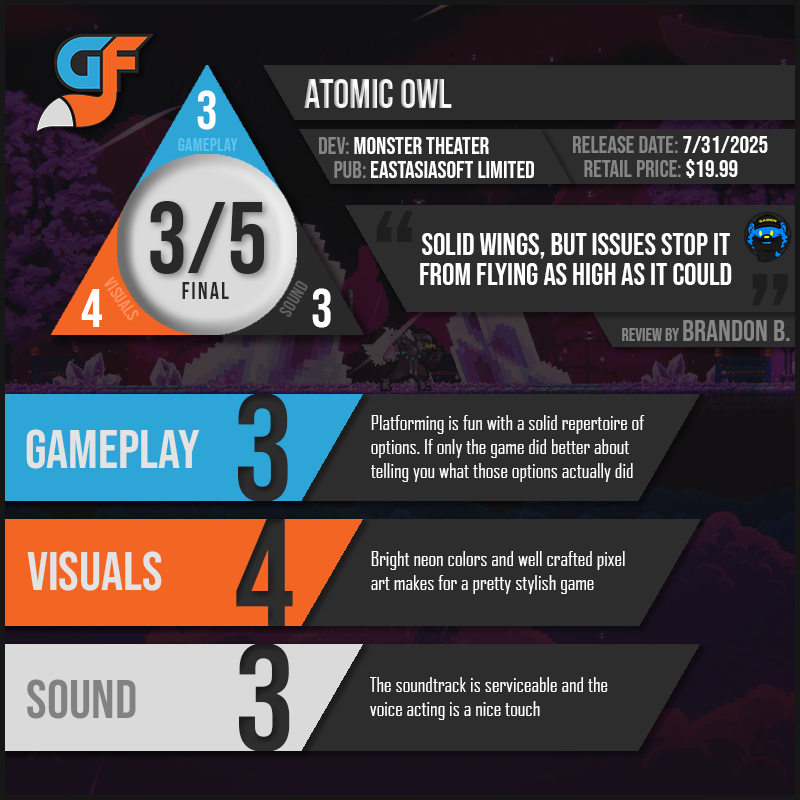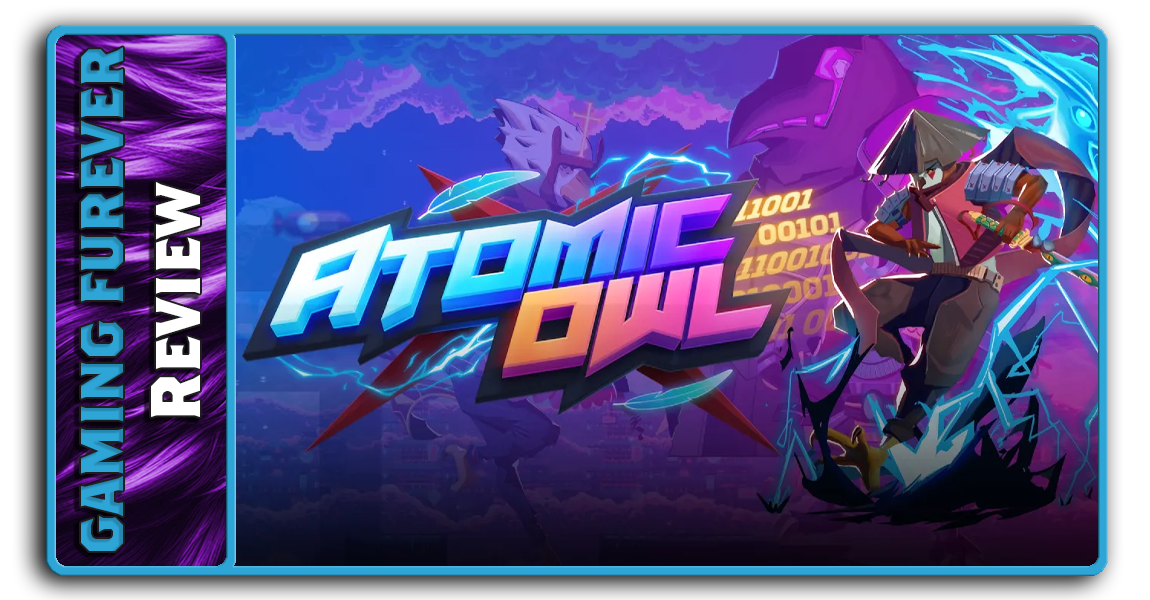Picture this: It’s a peaceful day in the city. You’re about to have lunch with friends when suddenly an enemy overwhelms you all with dark spiritual power. That’s the beginning of Atomic Owl. The latest from publisher eastasiasoft and developer Monster Theater, Atomic Owl sees players step into the wings of Hidalgo Bladewing, the prince of the Bladewings who just returned from a dangerous mission to chow down on ramen with his friends. Only for things to go horribly wrong as the malevolent Omega Wing appears and conquers Judanest, but not before imprisoning Hidalgo and corrupting the aforementioned friends. Two years later, Hidalgo is freed by Mezameta, his now sentient sword and two embark on a quest to stop Omega Wing.
The stage is now set so it’s time for the gameplay. As Hildalgo, you’ll be jumping, dashing and gliding your way across multiple levels while hopefully getting the power-ups you need. The platforming in this game is pretty tight and fun. Hidalgo has a double jump to start and a dash, both of which see plenty of use. As he darts his way across the screen, he’ll have to slow down to deal with the various enemies he encounters. He can do this with a regular attack from his sword, which can also be changed into a whip, axe or greatsword depending on situation and preference with a press of a button. Each of these weapons has their own benefits and downsides. The whip is limited to a single type of attack and fixed damage but is good for stopping projectiles and can hit from a little further away. The axe functions like the axes from Castlevania in which it’s thrown in an arc in addition to hitting up close. While the greatsword just hits harder while being slower. I appreciate the variety on display here. Hidalgo also gets a Yutamata, which functions as an auto homing ranged attack but only has so many uses before it needs recharging. Finally he can access a super form known as the Void Crow, where he hits like a truck and is practically invincible. There’s a lot of different ways to tackle the various tengu you encounter and you definitely need those options because the enemies can come in swarms.
Over the course of a run, enemies will occasionally drop power-ups like a triple jump, the ability to deflect projectiles or set enemies on fire. These are nice to find and definitely help with a run but at the same time, they feel a bit limited. What I mean is, I kept seeing the same ones over and over again. I’m pretty sure there’s not more than a small handful of them and I never had more than 3 at most. They also don’t feel like they make that much of a difference. Triple jumping is cool but it just doesn’t seem like it adds enough height and the fact that you can dash upwards following a jump anyway makes it superfluous. At the end of some levels is a boss encounter. These are generally fun, each boss has its own patterns and attacks which once learned, makes taking them down a cool challenge. Having to restart a run means facing these same bosses again but thankfully cutscenes can be skipped to save time and I honestly didn’t mind it.
In between runs, Hidalgo spawns in an area between life and death. A campfire lets him spend meza obtained from platforming and enemy vanquishing for permanent upgrades like additional uses of the Yutamata or additional life gain upon reaching a new stage. These are nice on paper but like the temporary power-ups, they don’t feel like they do enough. Additional throws of the Yutamata is nice and all, but if you know what you’re doing, you’re probably not using it that much to begin with. The most useful thing you can buy here is an extra “life” which lets Hidalgo avoid death the first time his hp runs out. Given how easy it is to sustain damage with all the obstacles and enemies the game throws at you, this makes a huge difference in preserving a run.
What doesn’t help, is how frustratingly vague the game can be. My biggest complaint is how unclear it is with some of its mechanics. The weapon swap feature I mentioned earlier is really cool but I wouldn’t have known about it if I hadn’t seen it pop up as a hint in a loading screen. The concept was never brought up at all in the brief tutorial. The descriptions for some things aren’t helpful either, like the life gain upgrade doesn’t bother to specify how much health it restores upon reaching a new stage. Just little things like that hindered my enjoyment of the game a bit. Which is a shame because there is a lot to like.
The game looks pretty good with its neon pixel art aesthetic. I enjoyed the bright colors and cyberpunk vibes I got from Bladewing City. The stages are pretty varied and I appreciate that Hidalgo and his friends are all different kinds of birds. Mezameta has a unique look for a sword and I appreciate how meta and cheeky the dialogue can get, even if it edges a bit close to cringeworthy. It’s a very stylish package. One that sounds decent too. I never tired of the tranquil sounds of Bladewing City or the more energetic boss music. It’s nothing too memorable or noteworthy but it serves its purpose. I respect that they managed to include voice acting for the main cast as well. Again, it’s not anything too mind-blowing but it’s a nice touch that helps the world feel alive.
Atomic Owl is a fun, if flawed, experience. Dashing through Bladewing City to save Judanest is cool and I appreciate that the game gives you plenty of options for doing so. There’s a cool premise behind it all, some interesting lore and lots of spectacle to look at it. As a platformer, it soars high and proud. As a roguelite, it’s still learning to flap its wings.

Shoutout to eastasiasoft for the early review copy!



